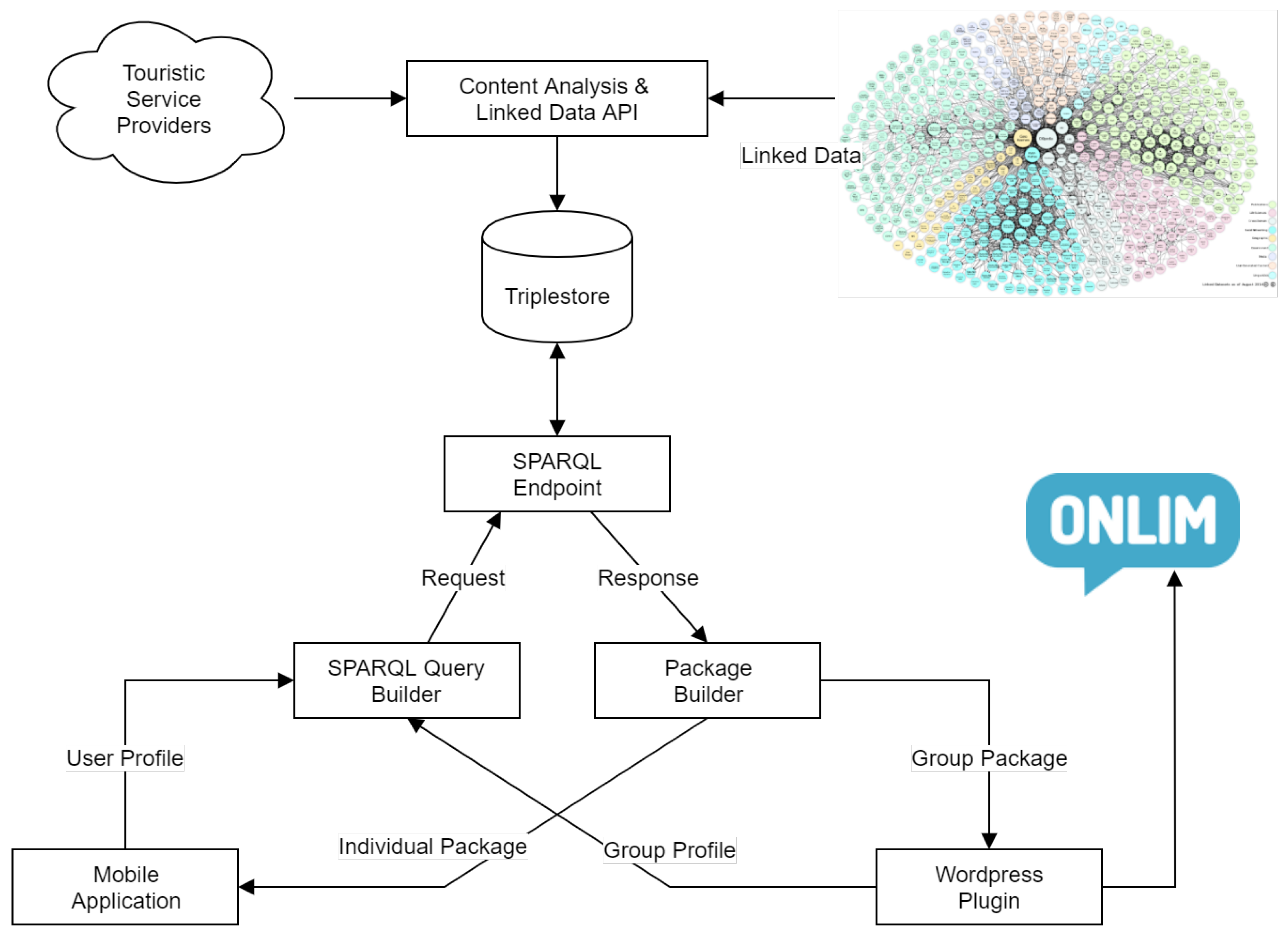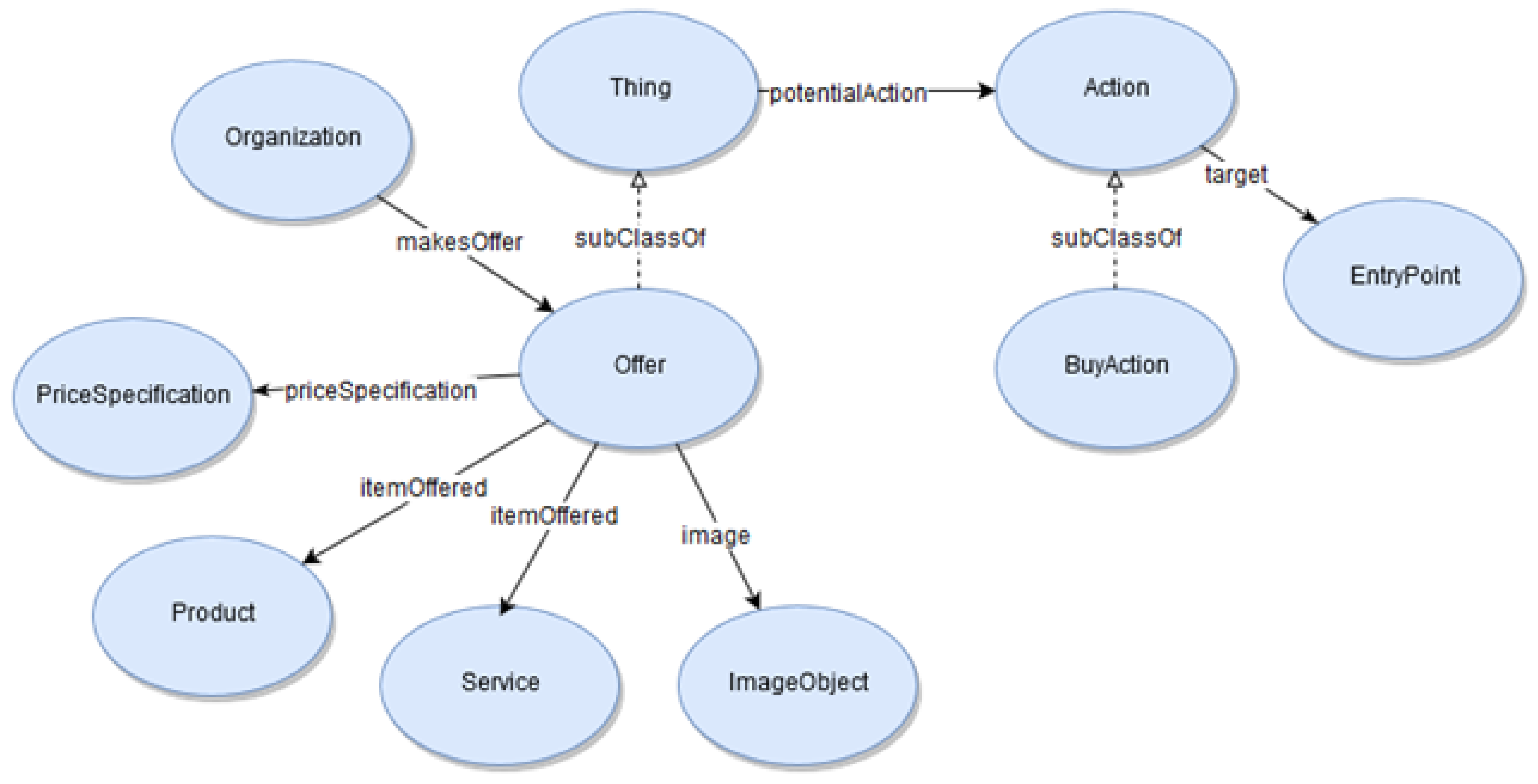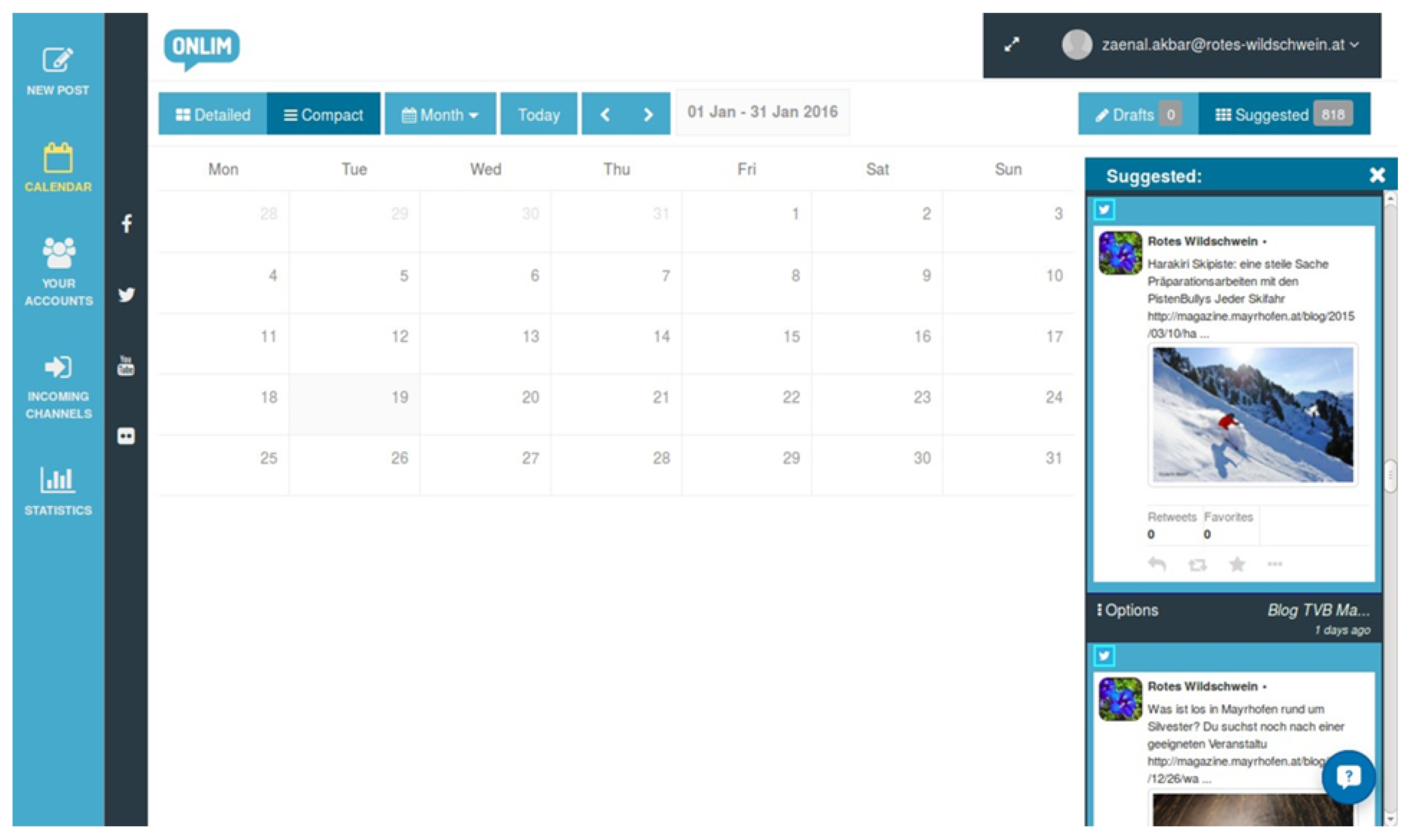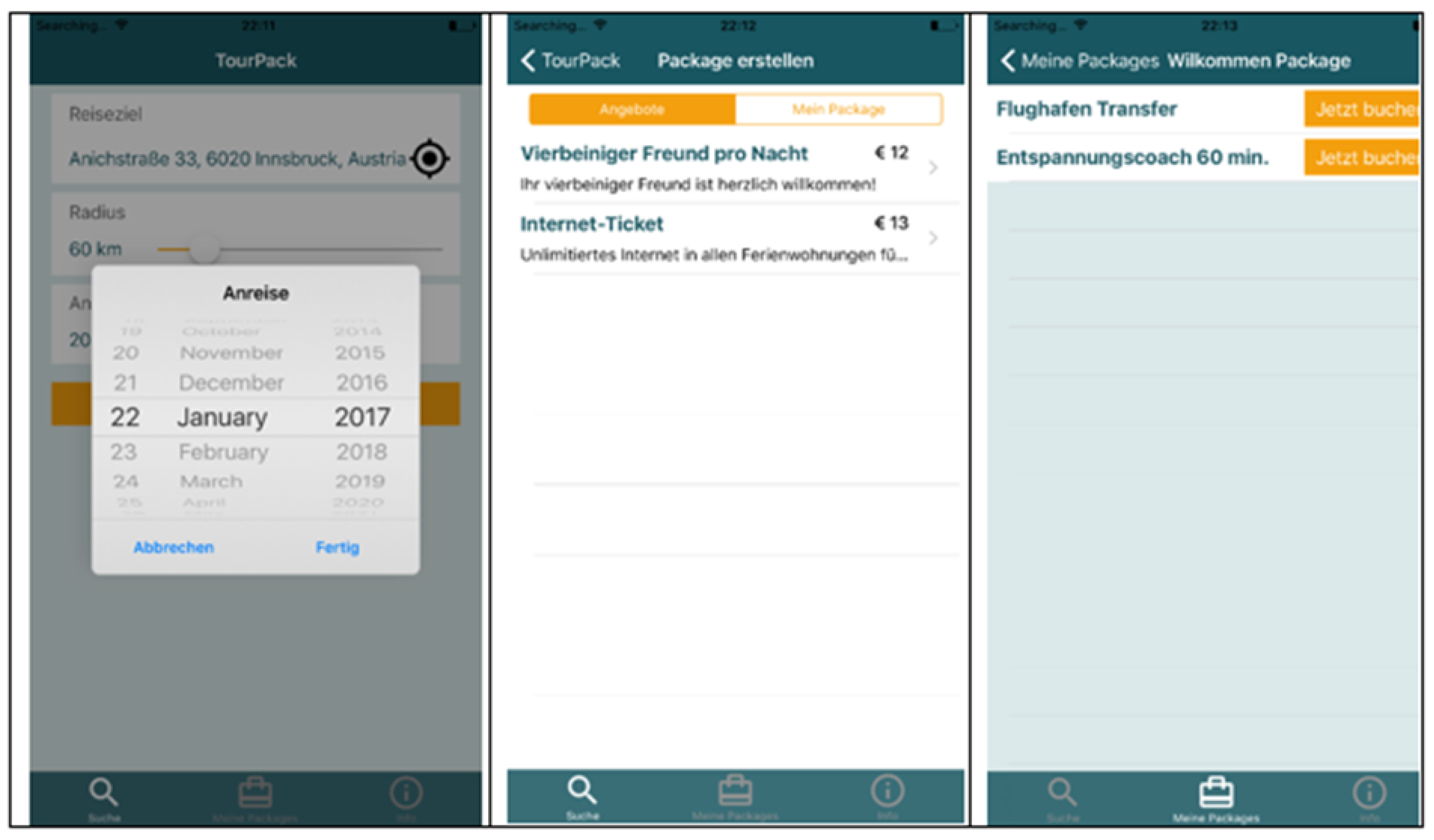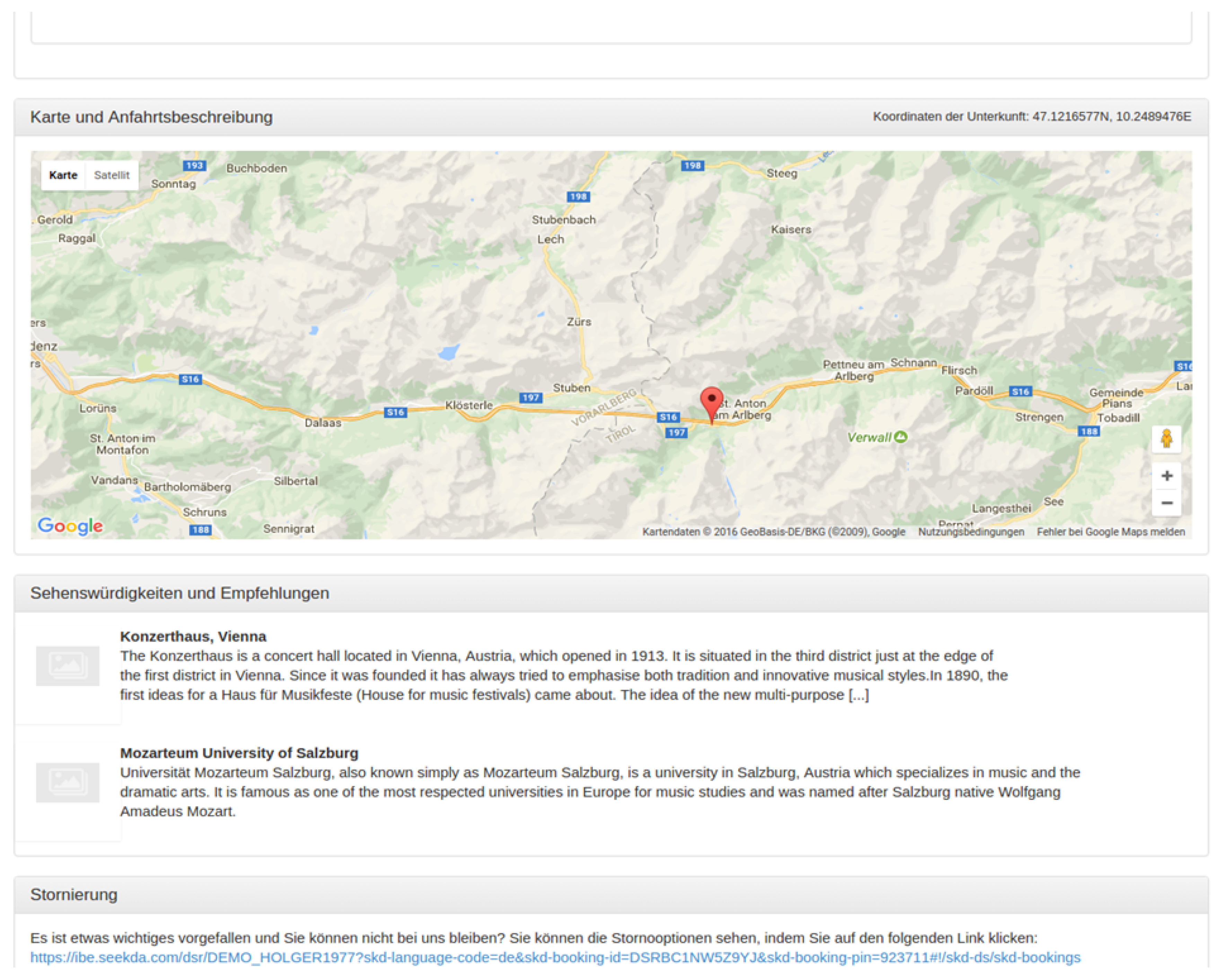1. Introduction
As end-consumers tend to spend more time online, in social networks, mobile apps, etc., and at the same time, the costs for using online booking and marketing platforms increase, online direct marketing and sales are becoming increasingly important, and even indispensable, for addressing potential customers. On the downside, the challenge is that the production of high-quality, attractive and engaging content, such as images, video clips, texts, for online channels requires creativity, worktime, skills and equipment, which most, especially smaller, businesses do not possess. Furthermore, the typical businesses do not have the content and data available for supporting their marketing; and they typically need to research:
which contents have already been published by other similar businesses online (e.g., because they want to be unique in their communication and avoid posting the same kind of contents many others have already posted),
how they compare to their competitors (e.g., because they want to refine their unique selling proposition),
which marketing strategies have been effective or less effective so far in their region (e.g., because they want to improve their customer relationship management).
Obviously, the quality of marketing and sales activities can be substantially improved if the marketing resources, both content and data, would be interoperable and shareable by the businesses located within the same region, while, when needed, being also efficiently deliverable beyond the region, globally, with the required level of reputation and quality. While the quantity of produced data is increasing, methodologies to manage their semantic structures, however, are currently only elaborated at the level of enterprises [
1], but not across enterprises on the web, as it brings further challenges. Further, as the regions and regional businesses are building their data and content management infrastructures that are multi-channel, supporting the social media and mobile use, as well as the content and data-sharing scenarios [
2], the need for the relevant interoperability and communication infrastructural technology increases.
In short, the companies and businesses need to present themselves on the Web, and best practice approaches for this are not identified. Further, it is typically unclear which data exact management challenges are to be encountered in such multi-channel direct online marketing systems. Our research aims in this work are to identify a reference solution for an online marketing system that needs to combine multiple sources of the data, and to identify the typical data management challenges that are appearing with the deployment of such a system. The reference implementation description of a multi-channel direct online marketing system and the identified maintenance data management challenges contribute to the modern systems implementing knowledge graphs, and set up best practices for the academia and industry.
To address this, from a methodological perspective, we conceptualize and prototype a technology ecosystem and infrastructure to interoperate across different marketing and sales data and content resources using Knowledge Graphs, built with Linked Data [
3] and semantic technologies [
4]. Knowledge Graphs are among the fastest-growing fields in computer science, with the vast majority of companies adopting or wanting to adopt them. Creation of the Knowledge Graphs is made with various means, ranging from the “classical” manual engineering to techniques supported by machine learning, see for example, the related developments of Google’s Knowledge Vault [
5] and at Alibaba [
6]. In our use case, Knowledge Graphs enhance representation structures and interoperability of distributed marketing and sales resources for allowing meaningful searches, efficient information dissemination and consumption. The approach combines and extends solutions for data acquisition and management, extraction and integration from the Web, data and content interlinking, semantic annotation and enrichment, and is implemented in the area of tourism services marketing. Further, we evaluate the prototype with the end-users, who understand both the technology side, as well as the end-user side. Based on this, we draw conclusions regarding the challenges in adoption of the technology, and outline the approaches to overcome the most common of them.
As in many service-oriented businesses nowadays, the touristic service consumers want individualized experiences [
7] and thus no longer want the “one-size fits all” touristic packages, as, for example, produced in a generic way by travel agencies. This imposes large challenges on data management, and has been a motivation for the TourPack project (On-demand Data-driven Production of Touristic Service Packages (TourPack):
http://tourpack.sti2.at), in whose settings we develop our approach. The aim of the TourPack project [
8] has been to design and prototype a production system that creates “on-demand” touristic packages catering to the individual touristic service consumer needs and preferences—applying the smart usage of the open and proprietary data for the information integration and service composition, and eventually, improving the multi-stakeholder data-driven production processes of touristic service offer, or, more specifically, to build a linked data-empowered system for touristic service packaging. Integrating information from multiple sources and systems employing linked data as a global information integration platform, and mining from the depths of the “closed” data, the touristic service package production system is to be able to create the most optimal travel experience for the traveler. Further, the service packages are to be efficiently published and made bookable to the end consumers via intelligently selected most suitable communication and booking channels: especially the online channels with rapidly growing user audiences, such as the social media and the mobile apps. The TourPack project has delivered the settings for our work, and in this paper we demonstrate its outcomes, specifically, addressing the data management and marketing aspect of this system.
This paper is structured as follows. The addressed problem and typical tourism domain user scenario examples are in
Section 2. In
Section 3, the current state-of-the-art is presented. Our approach to the solution and architecture is found in
Section 4.
Section 5 contains implementation details, and
Section 6 describes the evaluation.
Section 7 concludes and summarizes the paper.
3. State of the Art and Current Knowledge
Addressing our showcase domain of tourism, data-centric information channels for Austria currently provide machine-processable information such as mountain bike routes or public transport schedules, and restaurants with specific food preferences. Online services allow the booking of hotels (solutions are provided by companies like Kognitiv, Easybooking), ski passes (e.g., provided by SkiData), concert tickets (e.g., provided by oeticket), etc. Making touristic services easy to publish for the service providers and easy to find and book for the tourists are the key challenges for the production of a complete online service tourist offer package. Considering the abundance and variety of travel services and the restricted time travelers typically possess on vacations or on business trips, the touristic service search, selection and combination require a lot of effort from the service consumer. The methods to access and process the applicable structured Web data are currently evolving, while most of them focusing on the scenarios of consumption of linked data from semantic repositories [
12] and not yet investigating the use of all available distributed data to a full extent. In addition to addressing the holistic solution of the set research question (in
Section 1), our solution advances the state of the art in the individual state of the art cases, as described in the paragraphs below.
Overall within the touristic domain, service composition is a typically addressed problem, requiring ongoing adaptation and co-development of new technology and approaches e.g., for touristic planning [
13]. The creation of travel information services with spatial, social and temporal dimensions can be built already on Web 2.0 data, namely, as travel mashups [
14] or a broker platform [
15]. With the appearance of Linked Data and the global use of schema.org, the input coming from data processing components e.g., making decisions on yield management would be more and more present in service composition approaches.
The availability of the data is a basic enabler for the sufficiently high data quality, in particular, of the customer data, and in addition, the sharing of the data is essential for the modern marketing [
16]. There is also too much of marketing data and information available to choose from for the consumer [
17]. Our approach aims to leverage on all the richness of the available data, and at the same time employ the most relevant for the consumer data, information and content sources. The data is either available explicitly, or can be derived with the available algorithms e.g., for mining of user-profiles from social media, and the marketing content recommended based on this profile data [
18]. The possibility to generate high-quality user profile data from online interactions has been demonstrated, in particular via a touristic website [
19]. Another advantage of our approach is being able to analyze the data and content usage across multiple channels, which is essential for tracking and better understanding the customer journey [
20]. Our design’s aim is also to achieve the best choice outcome while minimizing the cost of the decision-making process, which is seen as essential for customer satisfaction [
21].
Furthermore, consumers are more and more interested in communication via different (and multiple) channels. The ability to answer customer demands wherever they are, and using the channel and device of their choice, will make a huge impact in their experience and consequently in the business. The fact that customers want access to all the services [
22] creates the necessity of an integrated strategy. Mobile services must be integrated in the business process, not seen as a separate endeavor. The latter, in particular, are a valuable source of personalized access, customer and business data, which should also be employed in a connected manner [
23].
To demonstrate the importance of the mobile experience, Google [
24] took a deeper look at users’ expectations and reactions towards their site experiences on mobile devices. Most interestingly, 61% of people said that they would quickly move onto another site if they did not find what they were looking for right away on a mobile site. The bottom line is that without a mobile-friendly site (that could be extended to mobile access to services) one will be driving users to the competitors. Having a great mobile site is no longer just about making a few more sales. It has become a critical component of building strong brands, nurturing lasting customer relationships, and making mobile work.
Regarding the mobile experience, many customers prefer interactions via online channels rather than face to face, a fact that is currently supported by the increased number of mobile devices within the customer’s reach. A combination of various online platforms and mobile applications including social networks would increase the opportunity for consumers to purchase goods and services online [
25]. An appropriate mobile strategy integrated into the online multichannel world will also benefit the management and customer service for the tourism business. Further, the technology would implement the known good practices of communications with the customers via the mobile phone channels [
26]. Given the requirements described above, our solution is integrating both mobile and social media interaction modes, in a holistic manner.
4. Approach and Enabling Technology
Our approach to the service marketing and integration aims to close the gaps of the approaches introduced above and create solutions for the dynamic integration of touristic web services on the fly that will enable the creation of enhanced integrated services. Consequently, based on linked data, the service offers will be distributed via the most appropriate channels. We have defined a system architecture (
Figure 1), and data management requirements regarding the components of the system.
As visible in
Figure 1, the solution takes in the closed data from touristic service providers as well as linked (open and closed) data, and forms valid touristic service packages. The information processing and representation are facilitated by schema.org-supporting plug-ins that implement Knowledge Graphs in content management systems, such as, e.g., in Wordpress and Drupal. After this, these packages are disseminated: both in an individual (tailored to a user profile) way, or via social media, pre-selected to tailor the typical audience of the touristic service provider, or, the kind of audience this service provider wants to receive.
There are two main components involved in the definition of the relevant packages. First, SPARQL Query Builder is responsible to construct a query to be executed on the knowledge graph stored in a Triplestore through a SPARQL endpoint. The query will be constructed based on the provided profile. For an individual package, a user profile will be collected through a mobile application, while for a group package, a profile will be collected through a CMS (e.g., WordPress) plugin. Technically, a profile consists of a list of types of services or names of service providers or keywords which are relevant to users. The second main component is Package Builder which is responsible for providing the relevant package to users. A list of services will be obtained from the knowledge graph through the SPARQL Query Builder component. The services will be ranked according to the defined profile. For example, if a user requested restaurants closer to his/her hotel, then the list of obtained restaurants will be ordered based on the distance from the hostel to every restaurant. If the user requested outdoor activities that are open until late in the night, then the providers will be listed based on closed time.
We support automatic generation, clustering and packaging of semantically annotated touristic service offers from a variety of sources. The Application Programming Interfaces (APIs) and components perform information extraction, clustering and publishing in order to:
obtain the extracted data in a linked data format, (semi-)automatically associating metadata;
generate service representations in a linked data format according to ontological models;
interlink, cluster, package and disseminate services in an automatic way;
provide a semantic service and an online interface for easy publishing and access to the above-mentioned functionalities.
The effort already has run pilots, such as with the Touristic Association of Innsbruck, and already implemented semantic dissemination support by implementing schema.org support on their website (Website of Touristic Association of Innsbruck:
http://www.innsbruck.info) and publishing the touristic data of the Innsbruck region as linked open data [
27]. In cooperation with the province of Salzburg (SalzburgerLand), the touristic data of Salzburg are published in a linked open data format with schema.org, and are usable (SalzburgerLand Data Hub:
http://data.salzburgerland.com) in particularly as the corresponding Knowledge Graph (Press release of the region of Salzburg on the Knowledge Graph:
https://newsroom.salzburgerland.com/daten/knowledge-graph/), and the appropriate mobile app support exists. We are deploying our solution also with direct touristic service providers: starting with hotels, and extending to further touristic services. Including relevant touristic services in the platform, we have made a classification of all types of touristic service providers. These are extracted from the websites of Austrian regional touristic associations. The complete list of these types, accompanied by real-life examples of Innsbruck’s touristic service providers is presented in
Table 1. Herewith, the service providers of all these types have a straightforward marketing contents provisioning via our system. As schema.org became a de-facto standard supported by Google, Yandex, Bing and Yandex, our solution can be applied globally with increasing ease.
5. Implementation
For the technical format for information collection, processing and modeling, we heavily rely on linked data and the de facto standard schema.org, and are involved in co-defining its extensions, particularly at W3C. We use schema.org for modeling and communication of touristic service packages, including its actionable components for the booking part (see
Figure 2 for our implementation).
For the knowledge repository construction, the datasets from Innsbruck Tourism, Kognitiv Hotels and Offers and Salzburg Tourism were put into a semantic format, which is used for linking data in the tourism area. Through the Redlink platform (Redlink Semantic Platform:
https://redlink.co/semantic-platform), we provide these data in a cloud and linked data -empowered data repository for storing the semantically structured data.
Redlink’s Content Analysis solution offers fact extraction, topic classification, and fact linking from textual and media documents in different languages. Users are able to send text and get back facts and entities that have been identified automatically. In addition, the service provides references to existing datasets (public datasets like Dbpedia and Freebase, as well as custom user-created vocabularies like a product database) about the entities identified in the content. Users can create their own custom configurations with some simple steps, e.g., for adding advanced natural language processing features or commercial datasets.
Based on open source technology, Apache Marmotta (Apache Marmotta:
http://marmotta.apache.org), we have extended the querying capabilities towards some requirements (e.g., implementing the GeoSPARQL extension [
28]). The data can be accessed by the partners via interfaces using REST/Web Service access and via SPARQL. Through the Redlink platform, it can be enriched via annotation engines and thus linked to a greater set of entities available in the LOD world. In addition to this, several datasets from “Open Government Data” in Austria for the respective regions, have been added. The resulting dataset has amounted to 2200 lodgings, 9834 locations, and 2114 offers—all available for construction of the package.
Rules for automatic information dissemination, particularly on social media, in the context of Online Communication and Marketing Tool (ONLIM) (
http://onlim.com) component, have been modeled, and the ontology to automate the online communication has been developed and published online [
29]. ONLIM is an online tool based on semantic technologies that aim to facilitate managing various information dissemination channels (such as chatbot systems, social media platforms) by means of publishing posts and tracking the feedback given by other users. ONLIM supports several social media platforms such as Facebook, Twitter, YouTube, LinkedIn, Xing and Flickr. It also allows users to schedule their posts to enable more effective social media management and marketing. In contrast to other similar tools, ONLIM also has an automatic post generation feature that creates posts for publication in social media from external sources. Content, data and services that are annotated with schema.org can be converted to the posts by ONLIM automatically. In addition, these posts can be automatically forwarded to all appropriate channels to disseminate the information about products and services, as well as their packages. The modeled rules for information dissemination perform content adaptation, e.g., addressing that the content is expected in various modes at various channels, as well as communication adaptation e.g., posts should be more frequent on some platforms rather than on the others.
We furthermore have compiled a list of third-party touristic services and their possible uses within the TourPack platform. Additionally, various APIs available for TourPack have also been mutually introduced to identify possible connection points for the TourPack platform implementation.
Further, we had made an analysis and visualization of the data collected from various machine and human sources, and forming the packages out of this data. The packages have been created in a way to take into account the different types of touristic service provided (e.g., a user would likely need one dinner and one hotel room and not two or more, etc., see the created detailed split in
Table 1), the time-based availability, user profile and further relevant criteria.
Research on data quality, and particularly, the data in schema.org format, has been another one of our major occupations. The schema.org data provides a very large source of open semantically-structured data, which is not always of a sufficiently high quality to generate the packages directly applicable for the bookings, e.g., it can state that there are more hotels in Tyrol, an Austrian province, than in Austria [
30].
For the presentation layer, the user interfaces are being rendered in two forms: social media platforms postings and mobile app postings. In order to define meaningful pilot applications, several possible use case scenarios have been defined to fulfill the requirements of the project consortium and focus on the target user groups. Along with the definition, several application mockups have been created iteratively using state of the art technology. These interfaces include web-based, as well as mobile, use-cases and were carefully evaluated by stakeholders and project partners.
The social media postings are automatically generated from the data using the ONLIM component, and are content-wise addressed to audiences which the touristic service provider already has on its social media platforms e.g., as subscribers, or as the ones it wants to attract. An example of such automatically generated touristic services packages is displayed in
Figure 3: the offered social posts are displayed on the right-hand side, and can be scheduled in a calendar. On the other hand, mobile apps can generate personalized messages, and technically can be implemented with varying mobile platforms and varying user interfaces. The key possibility here is to deliver a personalized user experience to the user. The implemented iOS-based example of the mobile app client, as described up to now, is depicted in
Figure 4. It allows us to search by date and select various services, and group them into individualized packages.
Author Contributions
Conceptualization: A.F., Z.A., E.K., C.B., P.P. and A.G.; Data curation: A.F. and A.G.; Funding acquisition: A.F., P.P. and A.G.; Investigation: A.F., Z.A., E.K., C.B., P.P. and A.G.; Methodology: A.F.; Project administration: A.F., C.B., P.P. and A.G.; Software: Z.A., E.K., C.B., P.P. and A.G.; Supervision: A.F., P.P. and A.G.; Visualization: E.K. and P.P.; Writing—original draft: A.F., Z.A., C.B., E.K., P.P. and A.G.; Writing, review & editing: A.F. and Z.A. All authors have read and agreed to the published version of the manuscript.
Funding
This work has been partially funded by the Austrian Research Promotion Agency (FFG) in the project TourPack within the program “Future ICT”, as well as in the project WordLiftNG within the Eureka, Eurostars Programme.
Acknowledgments
The authors gratefully acknowledge useful input from all TourPack project participants, and of the STI Innsbruck’s start-up ONLIM, specializing on online direct marketing (chatbots and social media).
Conflicts of Interest
The authors declare no conflict of interest.
References
- Pistofidis, P.; Emmanouilidis, C.; Papadopoulos, A.; Botsaris, P.N. Management of linked knowledge in industrial maintenance. Ind. Manag. Data Syst. 2016, 116, 1741–1758. [Google Scholar] [CrossRef]
- Pierdicca, R.; Paolanti, M.; Frontoni, E. eTourism: ICT and its role for tourism management. J. Hosp. Tour. Technol. 2019, 10, 90–106. [Google Scholar] [CrossRef]
- Bizer, C.; Heath, T.; Berners-Lee, T. Linked data: The story so far. In Semantic Services, Interoperability and Web Applications: Emerging Concepts; IGI Global: Hershey, PA, USA, 2011; pp. 205–227. [Google Scholar]
- Domingue, J.; Fensel, D.; Hendler, J.A. Handbook of Semantic Web Technologies; Springer-Verlag: Berlin, Heidelberg, 2011. [Google Scholar]
- Dong, X.; Gabrilovich, E.; Heitz, G.; Horn, W.; Lao, N.; Murphy, K.; Strohmann, T.; Sun, S.; Zhang, W. Knowledge vault: A web-scale approach to probabilistic knowledge fusion. In Proceedings of the 20th ACM SIGKDD International Conference On Knowledge Discovery and Data Mining, New York, NY, USA, 24–27 August 2014; pp. 601–610. [Google Scholar]
- Zhang, W.; Paudel, B.; Zhang, W.; Bernstein, A.; Chen, H. Interaction embeddings for prediction and explanation in knowledge graphs. In Proceedings of the Twelfth ACM International Conference on Web Search and Data Mining, Melbourne, Australia, 11–15 February 2019; pp. 96–104. [Google Scholar]
- Cabanas-Abascal, A.; Rodríguez-González, A.; Casado-Lumbreras, C.; Fernández-González, J.; Jiménez-López, D. POST-VIA: Develop individualized marketing strategies for tourists. In Electronic Business and Marketing; Springer: Berlin, Heidelberg, 2013; pp. 29–42. [Google Scholar]
- Fensel, A.; Kärle, E.; Toma, I. TourPack: Packaging and Disseminating Touristic Services with Linked Data and Semantics. In Proceedings of the 1st International Workshop on Semantic Technologies (IWOST), Changchun, China, 9–12 March 2015; pp. 43–54. [Google Scholar]
- Piercy, N. Positive and negative cross-channel shopping behaviour. Mark. Intell. Plan. 2012, 30, 83–104. [Google Scholar] [CrossRef]
- Fensel, A.; Toma, I.; García, J.M.; Stavrakantonakis, I.; Fensel, D. Enabling customers engagement and collaboration for small and medium-sized enterprises in ubiquitous multi-channel ecosystems. Comput. Ind. 2014, 65, 891–904. [Google Scholar] [CrossRef]
- Payne, E.M.; Peltier, J.W.; Barger, V.A. Omni-channel marketing, integrated marketing communications and consumer engagement: A research agenda. J. Res. Interact. Market. 2017, 11, 185–197. [Google Scholar] [CrossRef]
- Luczak-Roesch, M.; Hollink, L.; Berendt, B. Current directions for Usage Analysis and the Web of Data: The diverse ecosystem of Web of Data access mechanisms. In Proceedings of the 25th International Conference Companion on World Wide Web, Montreal, QC, Canada, 11–15 April 2016; pp. 885–887. [Google Scholar]
- Di Penta, M.; Esposito, R.; Villani, M.L.; Codato, R.; Colombo, M.; Di Nitto, E. WS Binder: A framework to enable dynamic binding of composite web services. In Proceedings of the 2006 International Workshop on Service-Oriented Software Engineering, Shanghai, China, 27–28 May 2006; pp. 74–80. [Google Scholar]
- Cano, A.E.; Dadzie, A.S.; Ciravegna, F. Travel mashups. In Semantic Mashups; Springer: Berlin, Heidelberg, 2013; pp. 321–347. [Google Scholar]
- Casillo, M.; Clarizia, F.; Colace, F.; Lombardi, M.; Pascale, F.; Santaniello, D. An approach for recommending contextualized services in e-tourism. Information 2019, 10, 180. [Google Scholar] [CrossRef]
- Peltier, J.W.; Zahay, D.; Lehmann, D.R. Organizational learning and CRM success: A model for linking organizational practices, customer data quality, and performance. J. Interact. Market. 2013, 27, 1–13. [Google Scholar] [CrossRef]
- Broilo, P.L.; Espartel, L.B.; Basso, K. Pre-purchase information search: Too many sources to choose. J. Res. Interact. Market. 2016, 10, 193–211. [Google Scholar] [CrossRef]
- Piao, G.; Breslin, J.G. Exploring dynamics and semantics of user interests for user modeling on Twitter for link recommendations. In Proceedings of the 12th International Conference on Semantic Systems, Leipzig, Germany, 12–15 September 2016; pp. 81–88. [Google Scholar]
- Arbelaitz, O.; Gurrutxaga, I.; Lojo, A.; Muguerza, J.; Pérez, J.M.; Perona, I. Web usage and content mining to extract knowledge for modelling the users of the Bidasoa Turismo website and to adapt it. Expert Syst. Appl. 2013, 40, 7478–7491. [Google Scholar] [CrossRef]
- Wolny, J.; Charoensuksai, N. Mapping customer journeys in multichannel decision-making. J. Direct Data Digital Market. Pract. 2014, 15, 317–326. [Google Scholar] [CrossRef]
- Wang, Q.; Shukla, P. Linking sources of consumer confusion to decision satisfaction: The role of choice goals. Psychol. Mark. 2013, 30, 295–304. [Google Scholar] [CrossRef]
- Gaffney, A. Improving customer satisfaction through more effective ICT strategies. Alcatel-Lucent Enrich. Commun. 2007, 1, 1–7. [Google Scholar]
- Stone, M.D.; Woodcock, N.D. Interactive, direct and digital marketing: A future that depends on better use of business intelligence. J. Res. Interact. Mark. 2014, 8, 4–17. [Google Scholar] [CrossRef]
- Google. What Users Want Most From Mobile Sites Today. Google Survey Conducted by Sterling Research and Smith Geiger. Available online: https://www.thinkwithgoogle.com/advertising-channels/mobile-marketing/what-users-want-most-from-mobile-sites-today/ (accessed on 28 April 2020).
- Shpak, N.; Kuzmin, O.; Dvulit, Z.; Onysenko, T.; Sroka, W. Digitalization of the Marketing Activities of Enterprises: Case Study. Information 2020, 11, 109. [Google Scholar] [CrossRef]
- Persaud, A.; Azhar, I. Innovative mobile marketing via smartphones: Are consumers ready? Market. Intell. Plan. 2012, 30, 418–443. [Google Scholar] [CrossRef]
- Toma, I.; Stanciu, C.; Fensel, A.; Stavrakantonakis, I.; Fensel, D. Improving the Online Visibility of Touristic Service Providers by Using Semantic Annotations. In The Semantic Web: ESWC 2014 Satellite Events; Springer International Publishing: Cham, Switzerland, 2014; pp. 259–262. [Google Scholar]
- Battle, R.; Kolas, D. Enabling the geospatial Semantic Web with Parliament and GeoSPARQL. Semant. Web 2012, 3, 355–370. [Google Scholar] [CrossRef]
- Akbar, Z.; Fensel, A.; Fensel, D. An Ontology-Based Coordination and Integration of Multi-Channel Online Communication. Int. J. Metadata Semant. Ontol. 2017, 12, 219–231. [Google Scholar] [CrossRef]
- Kärle, E.; Fensel, A.; Toma, I.; Fensel, D. Why Are There More Hotels in Tyrol than in Austria? Analyzing Schema.org Usage in the Hotel Domain. In Information and Communication Technologies in Tourism 2016; Springer International Publishing: Cham, Switzerland, 2016; pp. 99–112. [Google Scholar]
- Akbar, Z.; Kärle, E.; Panasiuk, O.; Şimşek, U.; Toma, I.; Fensel, D. Complete Semantics to Empower Touristic Service Providers. In On the Move to Meaningful Internet Systems; Springer International Publishing: Cham, Switzerland, 2017; pp. 353–370. [Google Scholar]
- Stavrakantonakis, I.; Fensel, A.; Fensel, D. Linked Open Vocabulary Ranking and Terms Discovery. In Proceedings of the 12th International Conference on Semantic Systems, Leipzig, Germany, 12–15 September 2016; Association for Computing Machinery: New York, NY, USA, 2016; pp. 1–8. [Google Scholar] [CrossRef]
- Kärle, E.; Şimşek, U.; Fensel, D. Semantify.it, a Platform for Creation, Publication and Distribution of Semantic Annotations. In Proceedings of the 11th Eleventh International Conference on Advances in Semantic Processing (SEMAPRO), Barcelona, Spain, 12–16 November 2017; pp. 22–30. [Google Scholar]
- Şimşek, U.; Kärle, E.; Holzknecht, O.; Fensel, D. Domain Specific Semantic Validation of Schema.org Annotations. In Proceedings of the International Andrei Ershov Memorial Conference on Perspectives of System Informatics; Springer International Publishing: Cham, Switzerland, 2018; pp. 417–429. [Google Scholar]
- Pellegrini, T.; Mireles, V.; Steyskal, S.; Panasiuk, O.; Fensel, A.; Kirrane, S. Automated rights clearance using semantic web technologies: The DALICC framework. In Semantic Applications; Springer Vieweg: Berlin, Heidelberg, 2018; pp. 203–218. [Google Scholar]
© 2020 by the authors. Licensee MDPI, Basel, Switzerland. This article is an open access article distributed under the terms and conditions of the Creative Commons Attribution (CC BY) license (http://creativecommons.org/licenses/by/4.0/).
